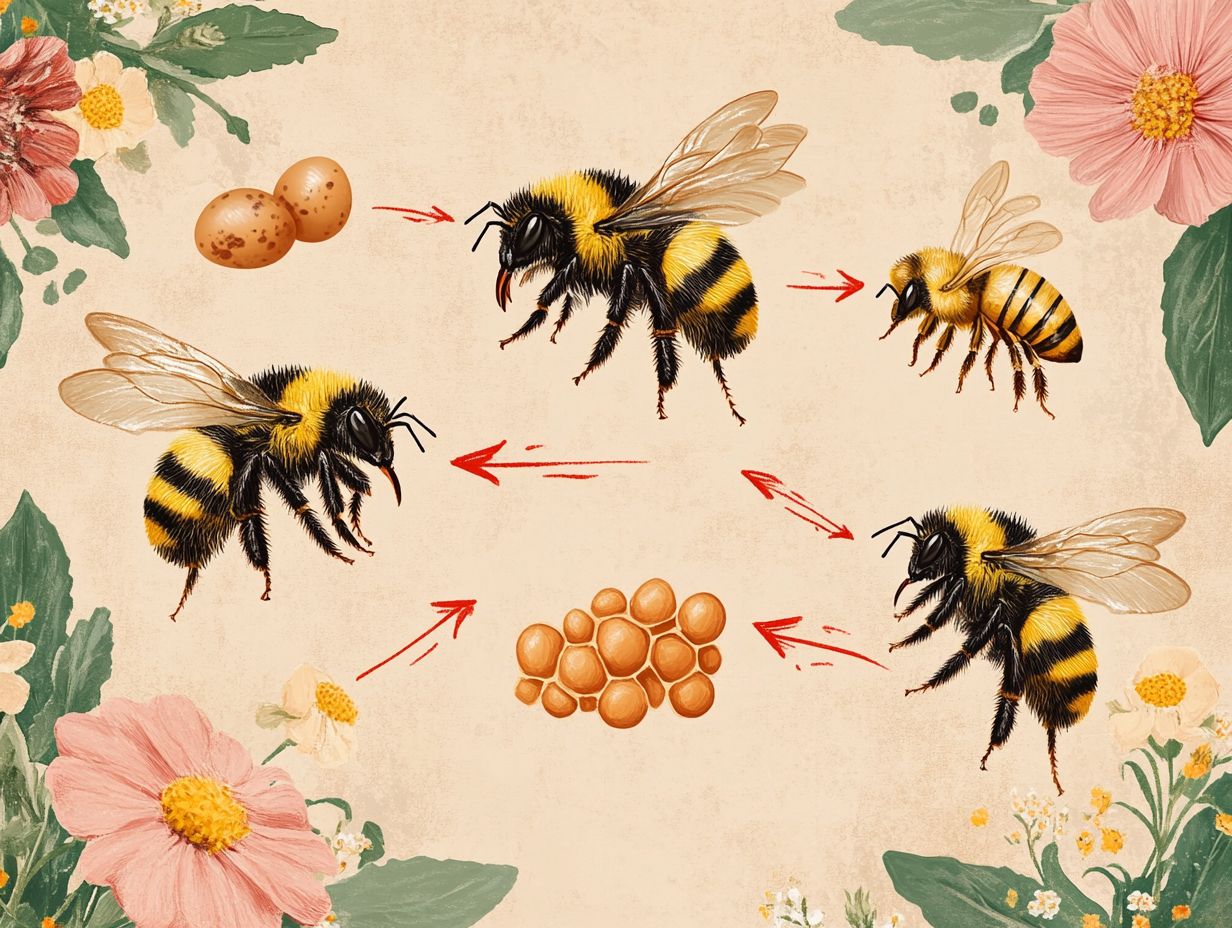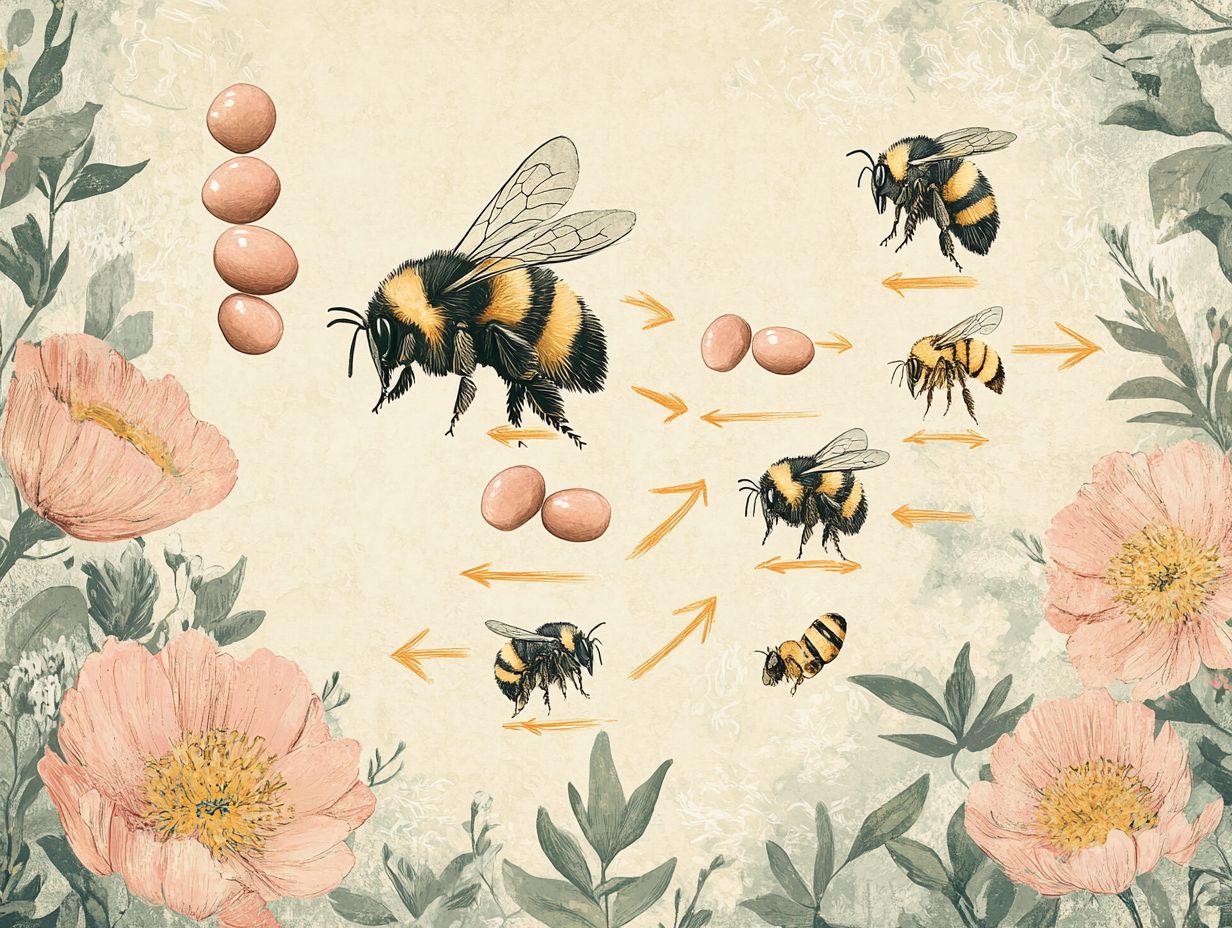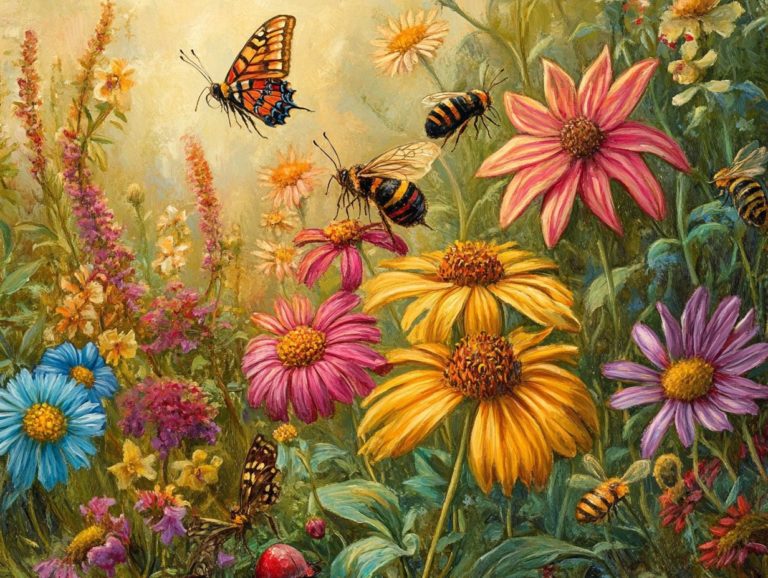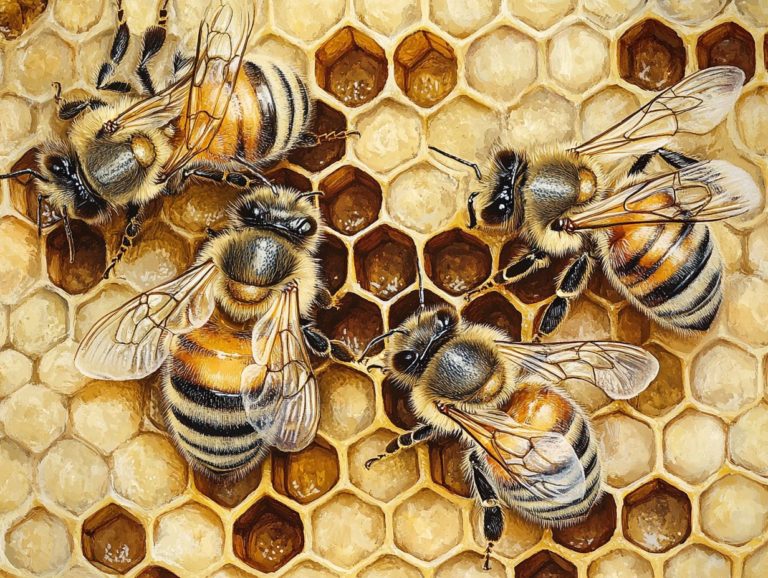The Lifecycle of a Bumblebee
Bumblebees are truly remarkable creatures, playing an essential role in our ecosystems as pollinators. By delving into their lifecycle from the queen to the worker and drone bees you can uncover the intricate dynamics that define their communities, including their diverse roles as foragers and caregivers.
This exploration takes you through each stage of the bumblebee lifecycle, from eggs to larvae to pupae to adults. It highlights their unique behaviors and the various threats they encounter, such as pesticides, climate change, and habitat loss.
It emphasizes how you can take meaningful actions, like gardening and conservation efforts, to protect these vital insects and help ensure their survival.
Dive into the fascinating world of bumblebees and see how they are vital to our ecosystem!
Contents
- Key Takeaways:
- What Is a Bumblebee?
- What Are the Different Stages in the Lifecycle of a Bumblebee?
- How Long Does a Bumblebee Live?
- What Are the Behaviors of Bumblebees During Each Stage of Their Lifecycle?
- Why Protect Bumblebees? Key Threats to Their Survival
- How Can We Help Protect the Lifecycle of Bumblebees?
- Frequently Asked Questions
Key Takeaways:

- Bumblebees have a unique lifecycle consisting of three stages: queen bee, worker bee, and drone bee, progressing from eggs to larvae to pupae before becoming adults.
- The average lifespan of a bumblebee is only a few months, but their impact on pollination and food production is vital.
- Threats to bumblebee populations include pesticides, habitat loss, and climate change. Act now by planting bee-friendly gardens, supporting conservation efforts, and advocating for sustainable agricultural practices.
What Is a Bumblebee?
Bumblebees, especially the Western Bumble Bee and the Cuckoo Bumblebee, are critical pollinators in ecosystems throughout Canada and Saskatchewan. They play a pivotal role in sustaining biodiversity and bolstering agricultural productivity.
These remarkable social insects are easily recognized by their sturdy bodies, striking coloration, and fuzzy coats. All of which enhance their efficiency in foraging nectar and pollen from an array of flowers.
Their presence is not just important for the vitality of numerous plant species; it also greatly influences the broader ecosystem, establishing them as a crucial species in conservation efforts and emphasizing the importance of habitat preservation.
What Are the Different Stages in the Lifecycle of a Bumblebee?
The lifecycle of a bumblebee unfolds through several distinct stages eggs, larvae, pupae, and adult. Each stage plays a vital role in the colony’s development. It all begins with the queen, who lays her eggs in the spring, setting the stage for a fascinating journey.
As the lifecycle progresses, the eggs develop into larvae and then into pupae, which is the stage between larva and adult when bees undergo transformation. Ultimately, this gives rise to adult bees, which consist of both workers and drones.
Each caste assumes specific responsibilities that are crucial for the survival and efficiency of the colony. Understanding this lifecycle is essential for anyone interested in conservation, ecological studies, and the impacts of environmental changes.
1. The Queen Bee
The queen bee is the leader of a bumblebee colony, responsible for important tasks of reproduction and ensuring the colony’s lifecycle endures. As the largest bee in her domain, she emerges from hibernation each spring to establish a new nest and lay her first batch of eggs. These will develop into the critical workers that sustain the colony throughout the summer months.
Her mating habits are crucial to the health and success of the entire colony. By mating with multiple drones, she ensures genetic diversity, which fortifies the colony’s resilience against diseases and environmental shifts. Once she has mated, she embarks on the essential process of egg-laying, carefully depositing her eggs into individual cells within the nest.
The queen’s health is of utmost importance; a thriving queen can lay thousands of eggs across the season. If she suffers an injury or falls ill, the consequences can be dire, leading to a reduction in her reproductive output and directly jeopardizing the colony’s structure and longevity.
The worker bees depend on her for the survival and continuity of their community, making her well-being a top priority in their intricate social system.
2. The Worker Bee
Worker bees are the backbone of the bumblebee colony. They take on many responsibilities crucial for maintaining the hive s functionality. You ll find them foraging for nectar and pollen, diligently feeding the queen and larvae, and tending to nest maintenance.
These dedicated female bees burst onto the scene in spring, ready to work tirelessly through the summer, gathering food to ensure the colony’s survival through the autumn chill.
Their contributions go beyond foraging. Their remarkable caregiving skills shine as they care for the next generation of bees, nurturing them from tiny eggs to buzzing adults. As they collect pollen and nectar, these industrious workers also engage in the critical process of pollination. This is vital not just for the colony’s food supply; it s essential for the broader ecosystem that thrives on diverse plant life.
By pollinating flowers during their busy foraging trips, worker bees play a pivotal role in fostering biodiversity and maintaining ecosystem health. Their tireless efforts directly support agricultural productivity, as many crops depend heavily on pollinators like them. This makes worker bees critical not only to natural environments but also to the human food systems that rely on their invaluable services.
3. The Drone Bee
Drone bees are the male bumblebees whose primary mission is to mate with a queen, ensuring the species continues its journey. Produced later in the summer, these bees have a brief lifespan, with their existence revolving solely around reproduction. Unlike their industrious female counterparts, they do not forage or maintain the nest.
Emerging in unison with the queens, drone bees make their presence felt during the breeding season when the colony’s reproductive dynamics reach their zenith. This synchronization significantly enhances the likelihood of successful mating flights.
Typically, you’ll find drone bees gathering in designated areas, eagerly awaiting the arrival of virgin queens. This instinctual behavior underscores their vital role in the reproductive cycle. While they may not engage in the daily operations of the hive, their genetic contributions are nothing short of invaluable. By introducing new genetic material, they promote diversity and resilience within the bee population.
This genetic variability is essential for adapting to environmental changes and countering pests and diseases. Ultimately, it plays a pivotal role in maintaining the overall health of the entire colony.
How Long Does a Bumblebee Live?

The lifespan of a bumblebee varies dramatically depending on its social roles within the colony. Queens tend to be the long-lived ones, often enduring through winter in a state of hibernation, while workers and drones have much shorter lifespans, typically ranging from a few weeks to a few months. Queens can live up to a year, while workers usually meet their end by summer s close, and drones don t stick around long after mating.
This variation in longevity is all about their specific roles. Bumblebee queens mate in late summer, storing sperm and entering a deep hibernation to ensure they survive until spring arrives. During this time, environmental factors like temperature and food availability become crucial for survival.
In contrast, worker bees are busy foraging and caring for the young, increasing their exposure to dangers and demanding constant energy, ultimately leading to a shorter lifespan.
Drones, on the other hand, are solely focused on reproduction, making their existence even more fleeting, especially as winter approaches and food supplies dwindle. The remarkable ability of queen bumblebees to withstand harsh conditions through strategic hibernation is a testament to their evolved survival strategy, allowing them to emerge in spring, ready to establish new colonies.
Fun Fact: Did you know that bumblebees can fly in light rain, unlike many other bees? This makes them essential pollinators even in less-than-ideal weather!
To support local bee populations, consider planting bee-friendly flowers and reducing pesticide use in your garden!
What Are the Behaviors of Bumblebees During Each Stage of Their Lifecycle?
Bumblebees exhibit fascinating behaviors throughout their lifecycle. These include nest building, foraging for food, and pollination. Each behavior is vital for the colony’s success and the ecosystem’s health.
In spring, queens diligently search for suitable nesting sites. During the summer months, worker bees busily forage for nectar and pollen, supporting their colony and promoting the diversity of nearby plants.
1. Nest Building
Nest building is an important part of a queen bumblebee’s activities in spring. She embarks on this task to create a secure environment for her brood, which is vital for their survival and reproductive success.
The queen typically seeks out a hidden location, often finding refuge in abandoned rodent burrows or amongst dense vegetation. This allows her to raise her young away from potential threats, such as predators and environmental changes.
Once she has identified the ideal site, she gathers materials such as dried grass, moss, and even feathers to craft a soft, insulated chamber for her eggs. This careful selection of nesting materials serves a dual purpose: it provides warmth and camouflages the nest from predators like birds and small mammals, ensuring the brood’s survival.
After constructing her nest, she lays several eggs, dedicating herself to their care and safeguarding them from environmental hazards. The importance of nest protection cannot be overstated; it directly impacts the survival rate of the larvae, ultimately influencing the colony’s ability to thrive and reproduce.
Through this meticulous behavior, the queen bumblebee plays an important part in sustaining her colony, ensuring its continued success in the ecosystem.
2. Foraging for Food
Foraging for food is essential for bumblebees. It allows them to gather nectar and pollen from a variety of flowers that sustain their colony and promote pollination. As a general forager, bumblebees can exploit a diverse range of floral resources, enhancing their adaptability and ecological significance.
With a keen sense of smell and vision, bumblebees seek out flowers by detecting specific scents and colors that indicate the presence of nectar. Visiting numerous plant species satisfies their nutritional needs and fosters biodiversity in the local ecosystem.
Foraging activities play a critical role in plant reproduction, as bumblebees transfer pollen from bloom to bloom, facilitating fertilization. This natural process leads to the production of seeds and fruits and supports entire habitats, highlighting the invaluable ecological services bumblebees provide.
3. Pollination
Pollination is a crucial activity that bumblebees undertake. They play an important part in the reproduction of flowering plants and contribute significantly to ecosystem health. As they transfer pollen from one flower to another, they enhance biodiversity and support food production.
With their distinctive fuzzy bodies and specialized mouthparts, bumblebees are uniquely equipped to collect and transfer pollen efficiently. They even employ a buzzing technique to release pollen, which boosts their effectiveness in the pollination process. This activity benefits individual plants by increasing seed production and fosters the growth of diverse crops that many animals, including humans, depend on for nourishment.
However, these industrious insects face numerous threats. Habitat loss, pesticide exposure, and climate change pose significant challenges, jeopardizing their populations and the vital pollination services they provide to both ecosystems and agricultural systems.
Why Protect Bumblebees? Key Threats to Their Survival
Bumblebees face serious threats that you should know about! Pesticide exposure, habitat loss, and climate change are just a few factors that adversely affect their populations.
These challenges also threaten biodiversity and the ecosystems that rely on bumblebees as vital pollinators. Act now to help protect these essential creatures!
1. Pesticides

Pesticides pose one of the most significant threats to bumblebee populations, disrupting their health and survival by affecting their foraging behavior and reproductive success. When exposed to harmful chemicals, these vital pollinators can suffer from reduced immunity, reduced foraging efficiency, and even mortality within their colonies.
Various classes of pesticides, such as neonicotinoids (a type of pesticide) and pyrethroids (another harmful pesticide), have harmful effects on the brain of bumblebees. These neurotoxins can disrupt their ability to navigate and locate food sources, drastically diminishing their pollination activities.
These chemicals also affect bumblebee reproduction, leading to fewer new queens and smaller colonies.
The decline in bumblebee populations carries profound implications for ecosystems. Their role in pollination supports a vast array of plants and contributes significantly to environmental health. A decrease in effective pollinators can lead to diminished crop yields and a loss of biodiversity, underscoring the urgent need for awareness and action against pesticide use.
2. Loss of Habitat
Habitat loss is a serious threat to bumblebees and our ecosystems! Urban development, agriculture, and changes in land use strip away the natural environments that these crucial pollinators rely on for nesting and foraging. Such alterations severely impede their ability to flourish, ultimately affecting biodiversity and the overall health of ecosystems.
As available nesting sites diminish, the challenges faced by these critical pollinators multiply. Without a diverse array of flowering plants that offer both nectar and pollen, bumblebees find it increasingly difficult to secure enough food. This directly impacts their reproductive success and survival rates.
The decline in their populations can trigger a ripple effect, leading to diminished pollination services for various crops and wild plants, thereby threatening food security and ecosystem stability.
To help bumblebees, we need to create pollinator-friendly habitats, restore native plants, and practice sustainable farming. These initiatives not only support bumblebees but also contribute to enhancing overall biodiversity and maintaining ecological balance.
3. Climate Change
Climate change presents a significant threat to bumblebees, transforming their habitats and disrupting their lifecycle patterns, including nesting, foraging, and reproduction. As temperature and weather patterns fluctuate, the delicate synchrony between bumblebees and the flowering plants they depend on becomes jeopardized, endangering their survival and the equilibrium of ecosystems.
With rising temperatures, you might notice bumblebees emerging earlier in the spring, creating a mismatch between their lifecycle and the availability of their preferred nectar sources. This disconnect hampers their foraging efficiency and can lead to reduced reproductive success due to insufficient food during crucial developmental phases.
Furthermore, shifts in seasonal patterns can alter the geographical distribution of both bumblebees and flowering plants, potentially isolating populations and diminishing genetic diversity.
Given these concerning trends, there is an urgent need for targeted conservation efforts aimed at preserving habitats, enhancing food sources, and implementing climate adaptation strategies. These actions are vital to safeguard bumblebee populations and the essential roles they play in pollination and maintaining ecosystem health.
How Can We Help Protect the Lifecycle of Bumblebees?
Here are some easy ways you can help protect the lifecycle of bumblebees:
- create pollinator-friendly gardens
- steer clear of harmful pesticides
- Join in supporting conservation efforts! focused on restoring natural habitats
By cultivating environments that foster their survival, you play a crucial role in ensuring that these essential pollinators continue to thrive within our ecosystems.
1. Planting Bee-Friendly Gardens
Creating a bee-friendly garden is crucial for conserving bumblebees by providing essential nectar and pollen from various flowering plants. By selecting native and diverse species, you encourage foraging and support the bumblebee lifecycle, while enhancing local biodiversity.
To create a welcoming space for these vital pollinators, consider incorporating flowers like lavender, sunflowers, and black-eyed Susans. These favorites attract bumblebees in abundance. A diverse habitat includes a mix of wildflowers, shrubs, and trees, fostering a rich ecosystem.
Ensure your garden blooms across different seasons, even in early spring and late fall, to guarantee food sources are available year-round.
Taking these actions will significantly help increase bumblebee populations and promote healthy ecosystems, benefiting other wildlife and plants in your area.
2. Avoiding Pesticides
Avoiding pesticides in your gardening and agricultural practices is essential for safeguarding the health and survival of bumblebees, which are sensitive to various chemicals. By choosing organic methods and using a mix of different pest control methods without harmful chemicals, you create a safer environment for these crucial pollinators.
Exploring alternative pest control methods, such as natural predators or biological controls, reduces risks linked to chemical exposure and fosters a balanced ecosystem. Your consumer choices impact the promotion of pesticide-free practices; when you support organic farming and products, you send a strong message to producers about the demand for bee-friendly practices.
You can also make a difference by participating in community initiatives that support sustainable agriculture. This emphasizes the importance of preserving bumblebee habitats and their invaluable role in pollination, contributing to a healthier environment for everyone, including diverse ecosystems.
3. Supporting Conservation Efforts

Supporting conservation efforts is vital for ensuring the survival of bumblebee populations and preserving biodiversity. Engaging with local conservation programs and supporting new laws can significantly impact habitat restoration and protection initiatives, especially in regions like Saskatchewan, Canada.
You can also make a difference by volunteering with organizations dedicated to pollinator protection. Your time and skills can aid in recovery projects. Financial contributions through donations to research programs, wildlife organizations, or community gardens that create bumblebee-friendly environments provide crucial resources for ongoing conservation work. These initiatives support the survival and mating of bumblebees.
Raising awareness about the threats bumblebees face such as habitat loss, climate change, and pesticide use empowers communities to unite, forming a broader network of advocates committed to preserving these vital pollinators. Collaborating can yield tangible results that benefit both bumblebees and ecosystems.
Frequently Asked Questions
What is the lifecycle of a bumblebee?
The lifecycle of a bumblebee consists of four stages: egg, larva, pupa, and adult. During these stages, they play various roles within their colony.
How long does it take for a bumblebee to go through its entire lifecycle?
The duration of a bumblebee’s lifecycle varies by species, temperature, and environmental factors, but it typically takes around 6-8 weeks.
Where do bumblebees lay their eggs?
Bumblebees lay eggs in underground nests, usually in abandoned rodent burrows or dense grass. The queen bee is responsible for laying the eggs.
What do bumblebee larvae eat?
Bumblebee larvae eat a protein-rich diet of pollen and nectar. Adult bees provide this vital food for their growth.
What happens during the pupal stage of a bumblebee’s lifecycle?
In the pupal stage, bumblebees undergo a fascinating change. They transform from larvae into adult bees inside a cocoon.
What is the lifespan of a bumblebee?
Bumblebees generally live for 4 to 6 weeks, depending on the species. The queen bee can live up to a year to establish the colony, while worker bees and males have shorter lives.






